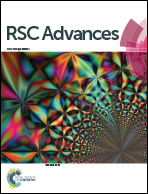Role of basicity and the catalytic activity of KOH loaded MgO and hydrotalcite as catalysts for the efficient synthesis of 1-[(2-benzothiazolylamino)arylmethyl]-2-naphthalenols†
Abstract
Novel KOH-loaded MgO and hydrotalcite as basic catalysts have been synthesized and were characterized by XRD, SEM and their basicity. The effect of the KOH wt%, reaction time, basicity and catalyst loading have been investigated in three-component reactions of aldehydes, 2-amino benzothiazole and 2-naphthol. The present studies showed the impact of KOH loading and reaction time. The best conversion and yield at 70 °C obtained were 93% and 88%, respectively. Hydrotalcite could be reused four times without a loss of the catalytic efficiency. Present catalytic system requires a short reaction time, is non toxic, easy to workup, has a good catalytic activity and gives a high efficiency.
![Graphical abstract: Role of basicity and the catalytic activity of KOH loaded MgO and hydrotalcite as catalysts for the efficient synthesis of 1-[(2-benzothiazolylamino)arylmethyl]-2-naphthalenols](/en/Image/Get?imageInfo.ImageType=GA&imageInfo.ImageIdentifier.ManuscriptID=C5RA11857C&imageInfo.ImageIdentifier.Year=2015)

 Please wait while we load your content...
Please wait while we load your content...